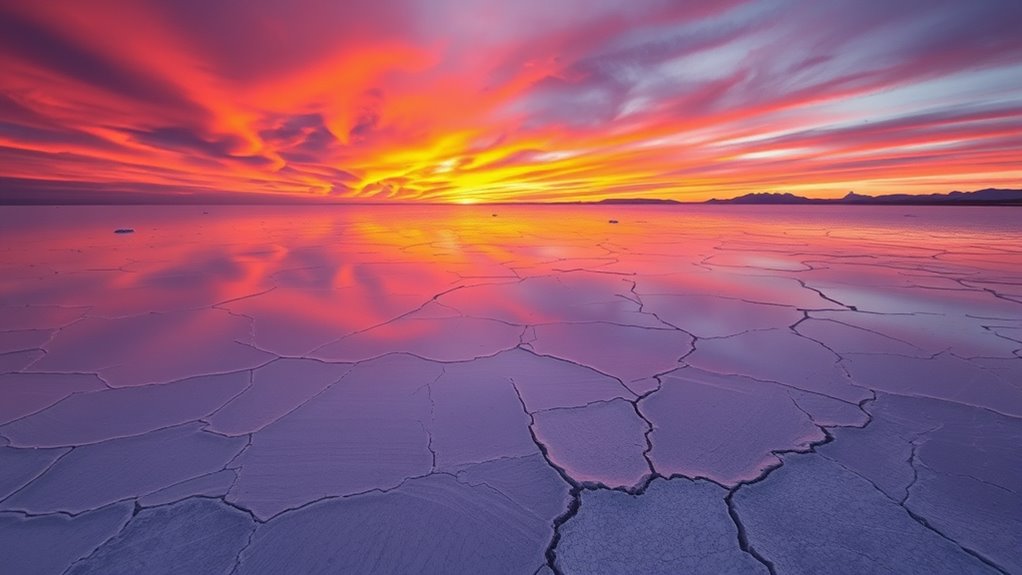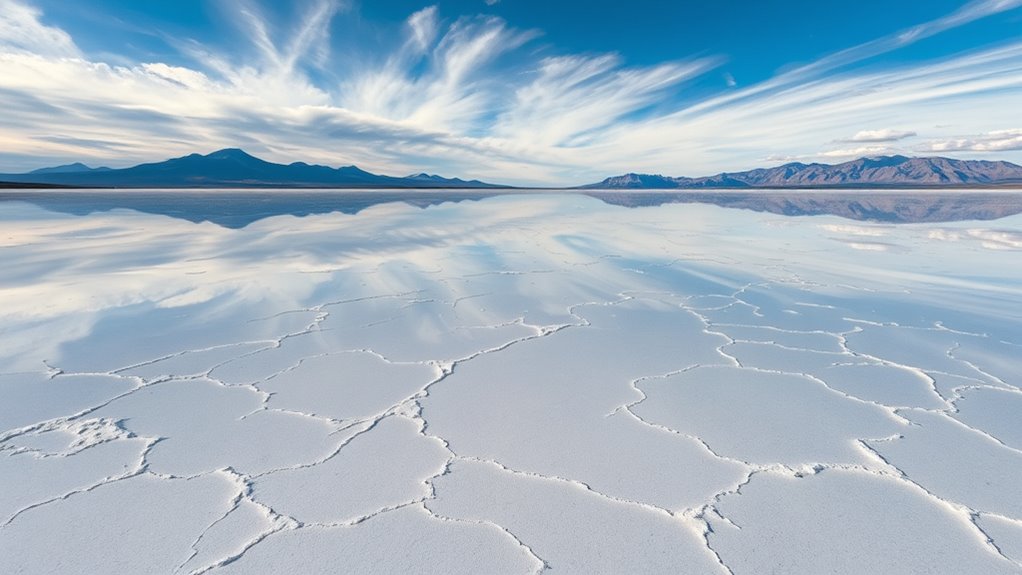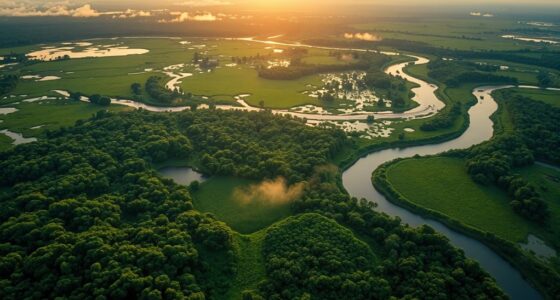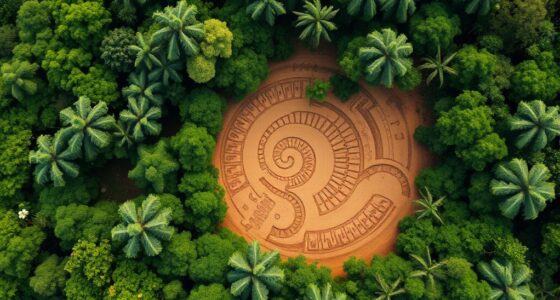The mirror-like surface of Salar de Uyuni forms because ancient lakes filled the basin, then evaporated, leaving behind concentrated minerals like salt, lithium, and potassium. As water evaporates, these minerals become saturated and crystallize into reflective layers of halite crystals, creating a smooth, mirror-like surface. Seasonal rains temporarily dissolve the salt crust, forming reflective pools before evaporation resumes. If you want to uncover more about how these natural processes shape such a surreal landscape, keep exploring.
Key Takeaways
- Salar de Uyuni formed from ancient lakes that evaporated, leaving behind mineral-rich sediments and deposits.
- Evaporation concentrates dissolved minerals, reaching saturation and triggering mineral crystallization on the surface.
- Crystals like halite create reflective, mirror-like surfaces that define the salt flats’ appearance.
- Seasonal rain dissolves surface salts temporarily, then evaporation restores the crystalline, reflective layer.
- Ongoing evaporative and crystallization processes continuously reshape and maintain the salt flats’ surreal landscape.

Nestled high in the Andes, Bolivia’s Salar de Uyuni is the world’s largest salt flat, but its striking landscape is more than just a natural wonder—it’s a product of complex geological and chemical processes. This vast expanse of white stretches as far as the eye can see, creating a surreal mirror-like surface that captivates visitors. To understand how this landscape forms, you need to grasp the underlying science—specifically, the roles of evaporative processes and mineral crystallization.
Over thousands of years, ancient lakes filled this basin, carrying dissolved minerals, primarily lithium, sodium, and potassium. As the climate changed, these lakes began to evaporate, a process *vital* to the formation of the salt flats. When water evaporates, it leaves behind the minerals dissolved within it. This evaporative process is the driving force behind the accumulation of salts and other minerals on the surface. As the water level drops, the concentration of minerals increases dramatically, eventually reaching a saturation point.
Ancient lakes evaporated, leaving behind minerals that formed Bolivia’s stunning salt flats.
Once the mineral concentration hits this *pivotal* threshold, mineral crystallization begins. Minerals start to come out of solution, forming solid crystals. You can think of it as nature’s way of “freezing” the minerals in place. These crystals accumulate over time, creating thick layers of salt and other mineral deposits that make up the surface of the Salar de Uyuni. The process is ongoing, as seasonal changes and continued evaporation keep replenishing and reshaping the landscape. Understanding mineral saturation helps explain the precise conditions needed for crystallization to occur.
The crystalline structure of these minerals, particularly halite (rock salt) and other salts, is what gives the surface its characteristic whiteness and reflective quality. When rainwater washes over the flats, it dissolves some of the surface salts, temporarily turning parts of the landscape into shallow, reflective pools. As the water evaporates again, mineral crystallization resumes, restoring the mirror-like surface. This cycle of evaporation and crystallization is responsible for the stunning, smooth appearance that makes Salar de Uyuni a natural marvel.
In essence, you’re witnessing a dynamic interplay of geological and chemical forces. The evaporative processes concentrate minerals, and mineral crystallization solidifies them into vast, reflective crusts. These processes have shaped the landscape over millennia, creating an otherworldly scene that’s both a scientist’s puzzle and a breathtaking spectacle. By understanding the science behind it, you gain a deeper appreciation of how natural processes forge one of Earth’s most mesmerizing environments.
Frequently Asked Questions
How Does Salt Crystallization Affect Local Ecosystems?
You might wonder how salt crystallization impacts ecosystems. When salt deposits form through salt deposition, they can disrupt ecological balance by altering soil chemistry and reducing plant diversity. This creates challenging conditions for native species, affecting animals and plants that rely on the environment. However, some organisms adapt to these salty conditions, showcasing nature’s resilience. Overall, salt crystallization shapes the delicate interplay within local ecosystems, influencing their long-term health.
What Are the Economic Impacts of Salt Extraction?
You’ll see that salt extraction boosts Bolivia’s economic development by creating employment opportunities for local communities. It generates revenue through exports and attracts tourism, which further supports the economy. However, over-reliance on salt mining can lead to environmental concerns and economic instability if global prices fluctuate. Overall, responsible salt extraction can positively influence the economy, but balancing growth with sustainability remains essential for long-term success.
How Does Climate Change Influence the Salt Flats’ Appearance?
You see the Salar de Uyuni’s stunning reflection, but climate variability and atmospheric effects threaten its beauty. Rising temperatures and changing precipitation patterns alter the salt flats’ moisture levels, causing the surface to crack or become uneven. These climatic shifts lead to less frequent or less intense rain, reducing the mirror effect. As climate change influences atmospheric effects, your chance to witness this natural spectacle may diminish, making preservation more urgent.
Are There Any Unique Minerals Besides Salt in Salar De Uyuni?
You’ll find that Salar de Uyuni isn’t just about salt; it boasts impressive mineral diversity. Besides salt, the salt flats contain minerals like lithium, potassium, and magnesium. The unique salt composition results from ancient lake deposits, creating a rich mineral mix. This diversity makes Uyuni a valuable resource, especially for lithium extraction, highlighting its significance beyond just its mirror-like surface.
How Do Scientists Study the Underground Salt Formations?
You might think studying underground salt formations is straightforward, but scientists rely on geophysical surveys and mineral sampling to uncover the truth. These methods help reveal hidden layers and mineral compositions, proving some theories about the salt flats’ structure. By investigating these formations, scientists deepen their understanding of the area’s geology, showing that even the most mirror-like surfaces hide complex, fascinating underground secrets waiting to be explored.
Conclusion
Now that you know the science behind Salar de Uyuni’s stunning mirror effect, it’s clear why nature’s wonders never cease to amaze. The perfect balance of salt, water, and climate creates this incredible spectacle. Remember, “a picture is worth a thousand words,” but experiencing it firsthand is truly priceless. So, keep exploring and appreciating the Earth’s incredible secrets—there’s always more to discover when you look a little closer.










